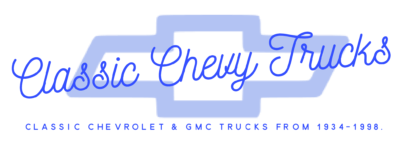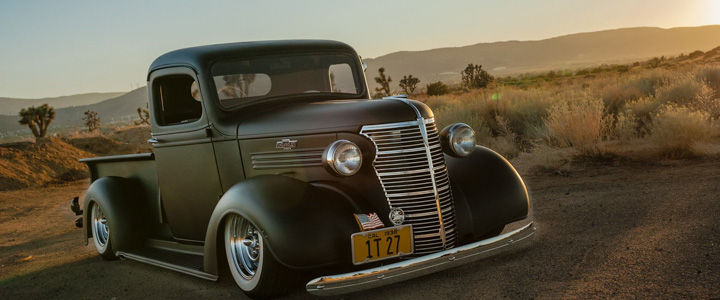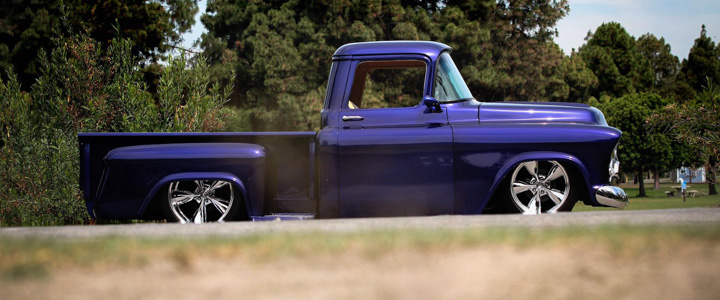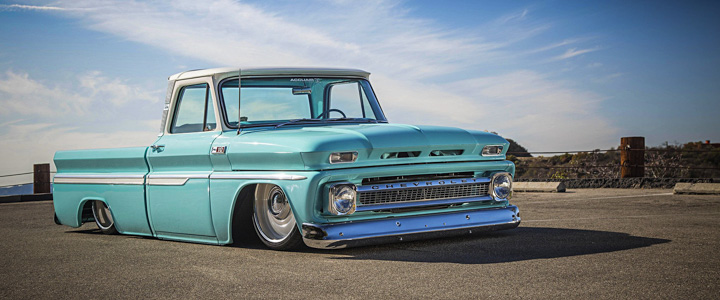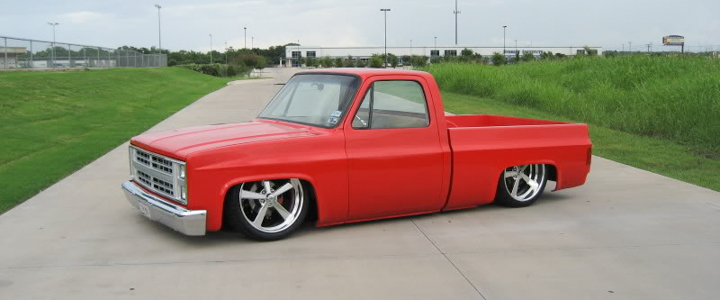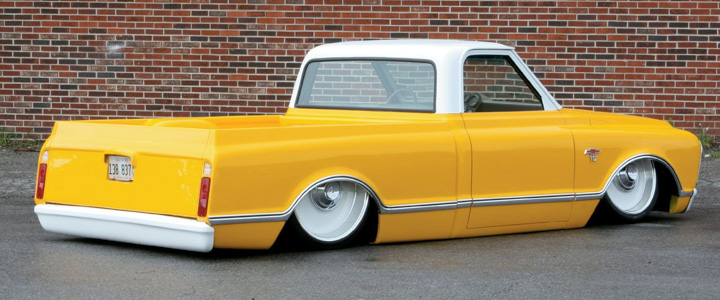
• Wing vent handles on the 1967 are carryover from the 1960-66. Therefore, the vent glass on the 1967 is correct only for this one year of the model series. It was not until 1968 that GM introduces the glass with a hole to hold the wing vent hardware.
• During 1962-72, the deluxe fleetside trim was bright anodized aluminum, rather than stainless steel in 1961 and older. This newer trim had been adopted throughout the automotive industry and saved in production costs.
• In 1967, GM offered both the small window and large rear window cab. However, between 1968 and 1972 the small window cab was only available on the C-60 or 2 ton truck.
• The 1967-68 cabs continue to have a park brake handle secured at the left under the dash. This system and handle had been used since 1955. Beginning with 1969 the park brake was activated by a foot pedal at the left side in the floor. This “new” position is almost the exact foot pedal location as used on light GM trucks between 1948-55 1st series. History repeats itself!
• General Motors, as most other manufacturers, were caught off guard when federal regulations began requiring side marker exterior lights. The 1967 truck (the first of the six years series) was already in the market place. GM’s only option was to stamp marker light rectangular holes in the vehicle sides to hold these new lights. Thus, the 1967 is the only truck of these series to not have these lights. It was not until the new 1973 body that designers added marker lights which would flow with the bodylines.
• With few exceptions during 1967-72, Chevrolet 1/2 and 3/4 tons used rear coil springs. Except for the Suburban, most all GMC’s had rear leaf springs. These leaf springs were an option on Chevrolets.
• The “Longhorn” 133” wheelbase pickup was available during 1968-72 and came in both 3/4 and 1 ton models. All had leaf-type rear suspension. Chevrolets are given a chrome die cast “Longhorn” emblem near the bedside marker light. GMC’s display a “Custom Camper” chrome emblem on each door. To save production costs, GM used the chassis from their current 1 ton stepside pickup. Its 133” wheelbase made it a natural for this longer fleetside bed. Prior to the Longhorn, GM had not placed a fleetside on their 133” wheel base pickup chassis.
• The panel truck with double rear doors had been a part of Chevrolet and GMC’s lineup since the early 1920’s. It experienced its final year during 1970, never to reappear again on a truck chassis. The increased popularity of vans is said to be the main reason for the decline in it’s sales. Today, seeing a 1967-70 panel truck is a rare occurrence!
• The wood bottom stepbed pickup (a standard since the 1920’s) continued to be available between 1967-72. The customer could still order stepbeds in 1/2, 3/4, and 1 ton sizes with wheelbases of 116”,127”, and 133” inches. In keeping with tradition, wood bed bottoms were still available on all fleetsides during 1967-72, however, they had now become an option over the standard metal corrugated style. The wood floors and bed strips were painted body color – never varnished or given a related clear coat.
• The stepbed body style was sold as the base price pickup. This kept GM competitive on their low price end and was often chosen by government agencies that were required to take the lowest price bid.. The deluxe side trim did not relate well to a stepbed with its rear fender. Therefore, horizontal side trim was not offered on this body style truck.
• Rear air conditioning on the suburban body made its first appearance in 1972. This was a recirculator unit with its own independent three speed fan control and evaporator.
• The factory installed AM – FM radio was first available in trucks in 1970, not 1967. It used a single under dash speaker. This was not a stereo unit.
• With the introduction of front disc brakes on 1971 light trucks, a small reflective decal was placed on the left corner of the tailgate, advertising this new advancement. On 1/2 tons, these new brakes changed the wheel bolt pattern from 6 to 5 holes. GM then began using pre-existing 15” wheels from larger cars, such as Pontiac and Oldsmobile.
• The top of the line Chevrolet pickups in 1967-70 were referred to as the CST (Custom Sport Truck). This changed in1971. The new term Cheyenne now related to their most luxurious vinyl interior and best wood grain exterior trim package. By 1972, an even more deluxe interior option was offered and designated the Cheyenne Super. It included a cloth pleated houndstooth pattern nylon seat cover with supple vinyl edging. A small red and chrome “Super” emblem is attached to the fenders under the Cheyenne nameplate and on the glove box door.
• The GMC equivalent to the 1971-72 Chevrolet Cheyenne is the Sierra. The 1972 GMC top of the line is the Sierra Grande and is identical in most areas to the Chevrolet Cheyenne Super.
• The 1972 year was the first for attaching the inside rear view mirror directly to the windshield.
• During 1972, a unique Chevrolet promotional pickup was introduced for a limited time in 1/2, 3/4, and 1 ton models. This truck was designated the “Highlander”. It did not have side emblems or related nameplates that would cause people to remember this special model. GM only listed the word Highlander on the glove box door inside ID sheet.
• The ralley wheels so often seen on restored 1971-72 1/2 tons are actually from the 1973 and newer pickups. Full wheel covers were the extra on the deluxe trucks.
• Doors on the 1967-72 body style interchange, however, the 1972 units are different. Where the wing vent vertical post meets the lower window opening, the 1972 only has a 1/4″ dimple! This is an improvement! Here, a horizontal metal screw helps better hold the two door halves together when exposed to rough use. Holes on the inside upholstery surface are also different because of the change in door panels.

